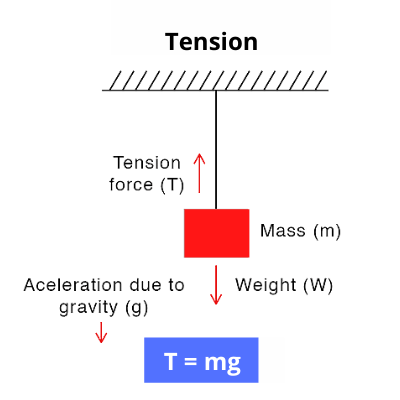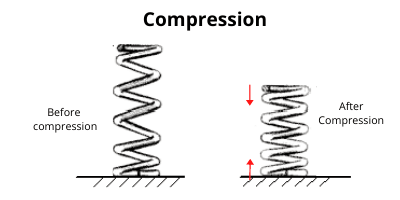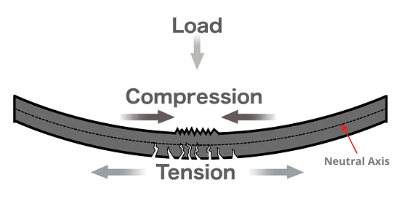Table of Contents
Tension Vs Compression
Tension and compression are the two principal forces involved in any structure/ building. Each material can handle a certain amount of tension as well as compression.
Some material possesses the excellent ability to bear compression, and some material can handle the tension easily.
Some materials can withstand both tension and compression effectively. For instance, if you pull a rope, it can handle a significant amount of tension, and if you push, it can resist compression significantly, only bend.
What is Tension?
A force that pulls the material apart refers to the tension force, and it tries to stretch a material.
When we fasten an object from a rope, the object’s weight pulls on the rope and tries to elongate the cord. This force is termed the tension force.

Due to this tension, the molecules that form a string are forced away from their equilibrium position.
The molecules try to come back to their equilibrium position. In doing this, they try they pull back on the object, attempting to elongate them.
If the force balance out, then the system becomes an equilibrium. But still, the string is following tension and possibly elongated beyond its original length.
The tension on a object can be represented numerically as:
T = mg + ma
Where;
T = tension in N (Newton)
m = mass, kg
g = gravitational force, 9.8 m/s2
A = acceleration, m/s2
The tension force per unit area refers to tensile stress, and the ratio of increase in length to the original length of material is called tensile strain.
What is Compression?
A force that squeezes or shorten material together refers to the compression force, and it tries to shrink the object.
For case, if we push down on the spring, we exert a compression force on it. If the compressive force acts in one direction, it refers to a uniaxial compressive force.

If the compressive force acts in two or three directions, they are called biaxial and triaxial compressive forces.
Generally, the Compression force is measured in Newtons (N) and it is represented by
N = ma
Where
m = mass in kg
a = acceleration due to gravity in n/mm2
The compressive force per unit section refers to compressive stresses. And the ratio of reduction in length to original length is referred to as a compressive strain.
Bending Stress
When material bends, it experiences both tension and compression simultaneously.
For example, let us consider a beam. When the load is applied on a beam, its bottom part experiences tension and its top part experience compression.
While a layer called the neutral axis runs along the middle of the beam, surprisingly, it experiences zero stresses during bending.

Also, Read – What is Shear Force and Bending Moment?
Both forces tension and compression are essential to keep in mind while designing a structure.
If we built a structure with a material that can’t handle tension and compression forces due to dead and live load, then the structure may collapse.
Hence all the structures must be designed to handle the forces act upon them.
Tension and compression forces are existing in all the structures. An engineer must design a structure able to withstand these forces without buckling and snapping.
Buckling happens when compressive force overcomes the material’s strength to handle compression, and Snapping occurs when tension force overcomes the material’s capacity to take tension.
The most excellent way to manage these forces is to either transfer them or dissipate them.
For transferring the force, move it from an area of vulnerability to a place of strength—the space designed to handle the force.
To dissipate the force, scattered it out over a large area so that no one place has to undergo the concentrated force’s impact.
An arch bridge is an excellent example of dissipation, and a suspension bridge is a perfect example of the transfer.
Difference Between Tension and Compression
| S.No. | Tension | Compression |
|---|---|---|
| 1. | Tension force tries to elongate the material. | In contrast, compression attempts to shorten the body. |
| 2. | It pulls materials apart. | It squeezes material together. |
| 3. | In tension, all forces are pulling away from the object. | In compression, the forces acting on the material push towards the body. |
| 4. | Tension may be linked to pulling on the ends of the material. | Compression may be correlated with pushing at the edges of the body toward the centre. |
| 5. | Generally, tension applies to strings. | It can be applied to any material. |
| 6. | The movement of the force in tension is outward from the body. | In compression, the movement of the force acting on the body is always inward to the body. |
Also, Read
H Beam vs I Beam – 15 Difference Between H Beam and I Beam
Difference Between Lap Length and development Length
Difference Between Compaction and Consolidation of Soil
Difference Between Mild Steel and Stainless Steel
Difference Between Marble and Granite
Difference Between MDF and Particle Board
Like this topic.
Thanks!